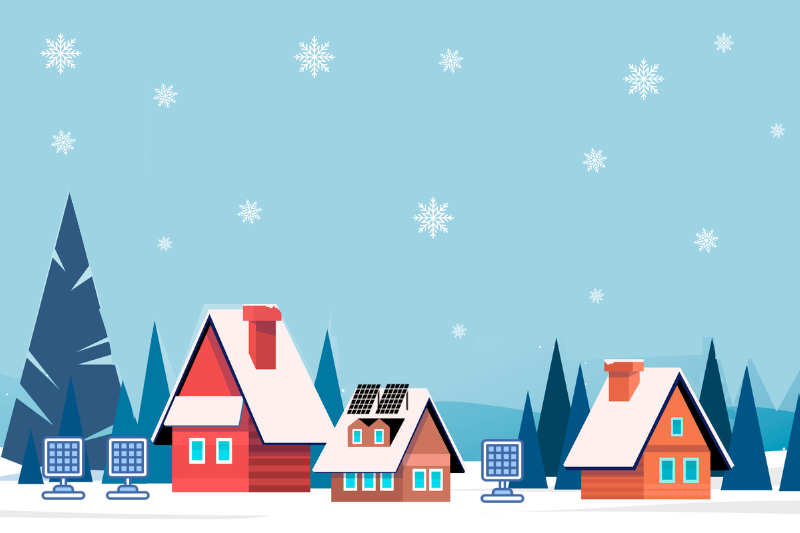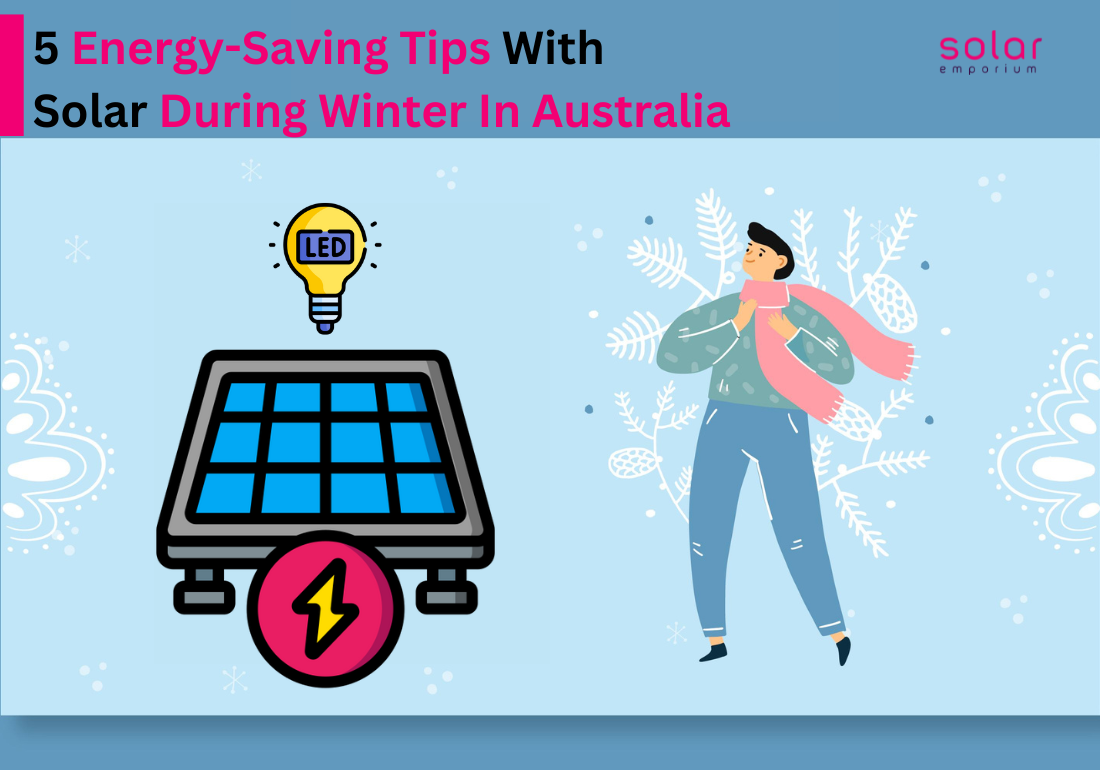Winter brings with it the desire to stay warm, which can increase energy consumption. These five tips will help you stay warm and comfortable without emptying your pockets with high energy bills.
So, what are the 5 energy-saving tips with solar during winter in Australia? You can also check out 10 energy-saving tips in Australia. It will provide a review of how you can save energy all year round.
But first, let’s understand your energy usage before we get into the tips. An average Australian household spends 40% of its energy budget on heating and cooling.
Get a smart monitor to have a better understanding of your usage habits. You can track your usage over time. It allows you to see how the seasons affect how you use energy.
With a smart monitor/meter, you can view a daily breakdown of your usage. You can also get the weather forecast properly.
Electricity and gas bills are out of control in Australia right now. And it gets unmanageable in winter because of the extra heating and hot water usage. However, simple changes in your daily habits can reduce your energy bills and save energy.
Use our energy-saving guide to immediately lower your electricity bills and save money on operating costs. Running your air conditioner, washing machine, and dryer can significantly increase your energy bill.
As winter approaches and the days become shorter, it’s an excellent time to consider your home’s energy efficiency. Since most of us spend more time at home, energy consumption increases in the daytime.
As a result, our electricity bills may be high. Consequently, it’s essential to consider your energy consumption and the possibility of lowering your power costs. Even minor changes can result in significant savings.
So here are 5 energy-saving tips with solar during winter for lowering your winter energy bill.
Install Solar Panels on Your Rooftop
Covering your roof with as many solar panels as possible is a step towards energy saving. You can save more money with more solar panels!
For starters, the demand for solar panels is growing year after year. In 2013, the average household solar panel installation was 4kW. That figure has recently risen to more than 8kW! It has more than doubled and continues to increase every year!
The average household has doubled to 8kW in just six years. If you haven’t upgraded, your system may need to be improved for electric vehicles and other electrical appliances.
And if your goal is to have a near-zero electricity bill, you can base it on average electricity usage. You must consider the cold winter months when solar production is the lowest and energy consumption is the highest.
A large system allows you to compensate for more significant energy fluctuations.
What happens if you buy an EV, batteries, and electricity for your household? Are your panels going to be ready for these extra appliances?
Data shows that Australia’s solar output will double in five years as more solar panels are installed.
Invest in solar today to reduce your electricity bill and carbon footprint.
Make Full Use of Your Solar Panels

Only installing solar panels in your home is not enough. You will need to benefit from the panels as much as possible.
Keep these things in mind to get the best results from your solar in winter-
- Running appliances during daylight hours is best because of the sunlight.
- High-energy appliances, such as your dishwasher and washing machine, should be run at different times. Again, daytime is always preferable but at another time.
- Charge your electrical devices during the day, when energy generation is at its peak.
- Turn off inactive appliances or devices and replace older appliances with energy-efficient models.
Invest In a Solar Battery
Purchasing a solar battery is a huge investment, but it takes time to get the value back. Even if you don’t have a lot of extra energy to store, it might be worth investing in a battery anyway. It’s an investment that will profit you for a long time.
The most common reason for purchasing a battery is that you have an electric-powered device that needs to be used after sundown or on stormy days. Some examples are using hot water, pool pumps, or charging electric vehicles.
During blackouts, you can also use the battery as backup power.
If you’re still heavily reliant on grid energy, this is one step closer to energy independence! With a battery, you can be optimistic that electricity will always be available without needing generators. Isn’t it wonderful to be the house with power when there’s a power outage?
So, how much will you save by installing a battery? The simple answer is $1,000 per year. Ten years later. You’ll start saving money a decade after you install the battery. Allow us to explain.
The most common household battery size ranges between 10kWh and 14kWh. Batteries cost $1,000 per kWh on average, so households typically invest $10,000 to $14,000 in one. A 10kWh battery system saves the average home around $1,000 per year.
As a result, even if you save $1,000 per year, it will take approximately ten years to recoup your battery investment. And now, with Tesla Powerwalls, you can save extra!
Reduce Your Energy Consumption
During the winter, solar panels can still capture sunlight and generate energy for your home. However, because there are fewer daylight hours, your solar panels will produce less power than in the summer.
That’s why you may need to decrease your energy usage or expect a higher electricity bill. And there are many ways to reduce your energy consumption, including:
- Change to energy-saving light bulbs. They are more durable and perform better. A 60-watt traditional light bulb can typically be replaced with a 15-watt energy-efficient bulb.
- Please turn off all appliances when they are not in use. While most know that leaving these things on wastes energy, we often overlook that it impacts our wallets.
- Small appliances should be unplugged. Even when not in use, they can consume a small amount of electricity, increasing your energy bill.
- Reduce the temperature on your thermostat. You can save money by lowering your home’s temperature by a few degrees. Layer your clothing to increase your comfort.
- Examine the insulation in your home. If your home is poorly insulated, more heat will escape, costing you money.
Get a Smart And Improved Heat Pump
Your heat pump works best between 18°C and 20°C. Blasts of high temperature may appear to be the most efficient way to heat a cold room. But using your heat pump will not heat your room any faster. On the other hand, it will significantly increase your energy consumption.
Use the timer function on your heat pump to pre-heat your space for 15 minutes before you want to occupy a room. And then set it off automatically when it’s no longer needed for the most cost-effective results.
Let’s assume you have applied all the tips to save energy in winter. But getting the most out of your solar panels requires an improved maintenance system.
So How To Maintain Your Solar Panels During Winter?

Solar panels are most known for producing energy on bright, sunny days, but they also work well in the winter. Cold temperatures will help solar panels work more efficiently.
But cloudier days and snow will almost certainly cause solar panels to produce less energy because of less sunlight.
Solar panels require a little more maintenance in winter to get the maximum output. And none of the tips below are mandatory. But you can generate more electricity even when the sun is down.
Adjust The Angle Of Your Panels
The sun’s angle in the winter differs from summer. As a result, adjust the angle of your solar panels during the winter to make the most of them. But most people will only be able to do it if solar panels are not mounted on fixed.
For those who can, adjusting the angle can help direct more sunlight to your panels.
Wipe The Snow From Your Panels
It’s natural for snow to fall in a snowy area. Automatically snow will fall onto your panels too. However, that is okay. Light snowfall will most likely melt quickly. Snow on your solar panels may be beneficial because it cleans your panels as they fall off.
Insulate Your Batteries Properly
It’s best to take a few extra measures to care for your solar batteries during the winter to ensure they function correctly. It is critical to keep your batteries at the proper temperature.
Batteries are not designed to operate in the cold that some areas experience. Consequently, your batteries should be stored indoors or in well-insulated containers.
If you store your batteries outside, monitor the temperature to ensure it’s within the ideal range.
Monitor Your Battery's Discharge
Solar Emporium Can Help You Save Money In Winter

Winter may be the most expensive time of year. Although you want to keep your home warm, increasing the temperature usually results in higher utility bills. Nobody enjoys being cold in their own home.
By implementing these practical winter energy-saving techniques, you can improve your home’s energy efficiency and save money on heating costs. You don’t have to be a home improvement expert to use our winter energy-saving tips.
Solar Emporium can provide you with additional energy-saving tips this winter. Our solar solutions have assisted Australians in lowering their energy bills. We are committed to providing the best premium solar solution for your home.
And we provide the most comprehensive selection of energy-saving solar panel solutions from leading solar suppliers. Schedule a free consultation with Solar Emporium’s experts to reduce energy costs immediately.
We are committed to finding the right high-quality solar solution for your home by offering a wide range of energy-saving solar packages.
Contact the Solar Emporium team for a free quote and save money on your energy bill immediately.

